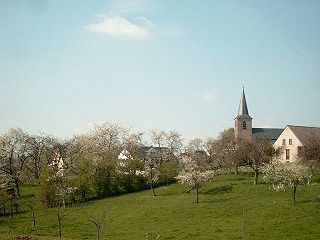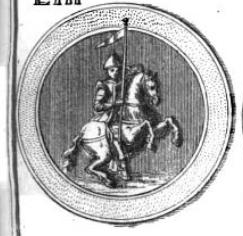
The County of Loon was a county in the Holy Roman Empire, which corresponded approximately with the Belgian province of Limburg. It was named after the original seat of its count, Loon, which is today called Borgloon. During the middle ages the counts moved their court to a more central position in Kuringen, which is today a part of Hasselt, the modern capital of the region.
Gerard I, Count of Guelders was Count of Guelders. He was the son of Theodoric of Wassenberg.

The Hesbaye, or Haspengouw, is a traditional cultural and geophysical region in eastern Belgium. It is a loamy plateau region which forms a watershed between the Meuse and Scheldt drainage basins. It has been one of the main agricultural regions in what is now Belgium since before Roman times, and specifically named in records since the Middle Ages, when it was an important Frankish pagus or gau, called Hasbania in medieval Latin.

Louis II was count of Loon between the end of the 12th century to 1218. He was the son of Gerard, Count of Looz, and Adelaide of Gelderland, daughter of Henry I, Count of Guelders, and Agnes of Arnstein, daughter of Louis III of Arnstein. He also claimed to be the legitimate Count of Holland during the Loon War (1203–1206).

Henry the Blind, sometimes called Henry IV of Luxembourg, was his father's heir as count of Namur from 1136 until his death, and heir of his mother's family as count of Luxembourg from 1139 until his abdication in 1189. He also inherited the smaller lordships of Longwy, La Roche-en-Ardenne and Durbuy.
Giselbert van Loon is the first definitely known count of the County of Loon, a territory which, at least in later times, roughly corresponded to the modern Belgian province of Limburg, and generations later became a lordship directly under the Prince-bishopric of Liège. Very little is known about him except that he had two brothers, one of whom, Bishop Balderic II of Liège, is much better attested in historical records.

Louis I was the Count of Loon, now in modern Belgium, and Burgrave of Mainz, in Germany. He inherited these offices from his father. He also established the County of Rieneck apparently based upon the Burgrave's lands.
Rudolf or Rodolphe, was a Lower Lotharingian noble born into a family with connections to Utrecht. He is thought by some modern interpreters to have later had lordships in the Hesbaye region which is now in Belgium, in a part which mostly came to be incorporated into the later County of Loon. He was a son of Nevelung, Count of Betuwe, and a daughter of Reginar II, Count of Hainaut, whose name is not known. He had two uncles, one paternal and one maternal, who were both named Rudolf, and various proposal have been made about how the three Rudolfs correspond to various references to "Count Rudolf" in the 10th century "low countries". Although his paternal uncle Rudolf is sometimes considered to have become a cleric, Jongbloed (2006) argued that he must have been a count, and that he certainly had a wife and offspring. There is no contemporary record of young Rudolf, the nephew, as a count, nor indeed as an adult.
Otto is a purported Count of Loon and father of Count Giselbert, who would have been adult roughly around the years 980–1000. He appears in only one much later document that is considered unreliable, so his existence is doubted. The list of the counts of Loon is normally started with Giselbert.
Count Gerard of Loon, was son and successor of Louis I, Count of Loon, and Agnes of Metz. He was count of Loon and of Rieneck. Because of a widespread misunderstanding concerning a document from 1101, some generations earlier, he is sometimes wrongly referred to as the second Gerard in this dynasty, "Gerard II".
Henry, Count of Looz and Count of Duras, son of Gérard II, Count of Looz, and Adelaide of Gelderland, daughter of Henry I, Count of Guelders, and Agnes of Arnstein, daughter of Louis III of Arnstein.
The pagus or gau of Hasbania was a large early medieval territory in what is now eastern Belgium. It is now approximated by the modern French- and Dutch-speaking region called Hesbaye in French, or Haspengouw in Dutch — both being terms derived from the medieval one. Unlike many smaller pagi of the period, Hasbania apparently never corresponded to a single county. It already contained several in the 9th century. It is therefore described as a "Groẞgau", like the Pagus of Brabant, by modern German historians such as Ulrich Nonn.
Count Rudolf, was a count in Lower Lotharingia, who apparently held possessions in the Hesbaye region and in the area of Meuse river north of Maastricht. It has been proposed that he was a son of Reginar II, Count of Hainaut, and thus a member of the so-called Regnarid dynasty.
The County of Duras was a medieval county with its seat at the castle of Duras. The 18th century version of this castle still stands and is a part of modern Sint-Truiden in the province of Belgian Limburg. The county was one of several counties in the Hesbaye region which covers the south of Belgian Limburg, and stretches into the neighbouring provinces. As a distinct entity under the name Duras the county only existed within the 12th century. After the first male line of counts died out, the county of Duras came by marriage to the Counts of Montaigu, whose other holdings were further south. Later they became part of the neighbouring County of Loon, which was ruled by cousins of the original counts of Duras.
Count Otto of Loon as he was known during his own lifetime, was founder of the family of Counts of Duras, and brother of Emmo, Count of Loon, one of the first known counts of Loon. In contemporary and later medieval records he is mainly known for his role as advocate of Sint-Truiden Abbey, which is today in Belgian Limburg.
Count Giselbert (or Gilbert) (d. before 1138), was the deputy advocate (subadvocatus) of Saint Trudo’s Abbey. At least by 1111 he began to be referred to as not just a count, but specifically the Count of Duras, and he may have been the first to be known under that title. He was son of Otto I, Count of Duras, and his wife Oda. Giselbert was involved in several conflicts which involved the abbey, as mentioned in several parts in the Abbey's Gesta or chronicle.
The Counts of Montaigu were 12th century nobles of Lower Lotharingia who were closely associated with the Counts of Duras and Clermont. This particular place called Montaigu was a castle located on the river Ourthe, opposite Marcourt near La Roche in the Ardennes. The castle of Montaigu has been mostly destroyed, but a chapel dedicated to Saint Thibaut still exists upon the mountain on which it was built.
Count Godfried was Count of Montaigu and Clermont by inheritance, and Count of Duras by virtue of his marriage. He was also seigneur (lord) of Rochefort, and advocate of Dinant.
Gilles (Ægidius), was Count of Montaigu and Clermont, through his father Count Godefried of Montaigu, and Count of Duras, through his wife Juliane, daughter of Count Otto of Duras. Gilles was also Seigneur of Rochefort, Jodoigne and advocate of the abbey of Saint-Trond.
Conon II (Cono) (died 1189 or after), Count of Montaigu and Count of Duras, son of Godefroi, Count of Montaigu, and his wife Julienne, daughter of Otto II, Count of Duras.